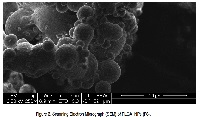Development and In Vitro-In Vivo Evaluation of Oral Drug Delivery System of Acyclovir Loaded PLGA nanoparticles
Keywords:
Acyclovir, PLGA, nanoparticles, 3ñ factorial design, sustained release, in vitro-in vivo evaluationAbstract
Acyclovir (ACV) is an antiviral drug, used for treatment of herpes simplex virus infections with an oral bioavailability of only 10 to 20 % (limiting absorption in GIT to duodenum and jejunum),half-life about 3 hrs, soluble at acidic pH (pKa 2.27) and distilled water at 37ºC. Polymeric nano drug delivery systems of ACV have been designed and optimized. Poly (lactic-co-glycolic acid) (PLGA) (50:50) was used as polymer and Pluronic F68 was stabilizer. In vitro evaluation of prepared formulations showed drug entrapment up to 90.06 % and particle size from 395nm. Drug: Polymer ratio and concentration of stabilizer were found to influence the particle size and entrapment efficiency of ACV loaded PLGA nanoparticles (NPs). In vitro drug release studies indicated controlled and sustained drug release of drug for a period of 32 hours. In vivo evaluation was carried out for selected formulations in comparison with marketed tablet (Zovirax®) in rabbits. The AUC values for developed formulations clearly indicated two to three fold improvement in bioavailability of ACV when compared to Zovirax® tablets. These preliminary results indicate ACV NPs are superior to marketed tablet Zovirax® as particle size and release rate of entrapped drug is controlled, which results in enhanced bioavailability and probable decrease in dose and dosing frequency. Ultimately increasing adherence to drug therapy and patient comfort.
References
Emmert DH, Treatment of common cutaneous Herpes Simplex Virus Infections. Am. Fam. Physician. 2000;61:1697-704.
Madhivanan, Purnima et al. The Epidemiology of Herpes Simplex Virus Type-2 Infection among Married Women in Mysore. India. Am. Sex. Tran. Diseas. Asso. 2007;34(11):935-37.
Tran T, Druce J, Catton MC, Kelly H, Birch CJ. Changing epidemiology of genital herpes simplex virus infection in Melbourne, Australia, between 1980 and 2003. Sex Transm Infect. 2004;80,277-79.
Wagstaff AG, Faulds D, Goa KL. Aciclovir: A reappraisal of its antiviral activity, pharmacokinetic properties and therapeutic efficacy.1994; Drugs. 47,153–205.
Roser M, Fischer D, Kissel T. Surface-modified biodegradable albumin nano- and microspheres. Eur J Pharm Biopharm.1998;46:255–63.
Claudia G et al. Influence of Preparation Conditions on Acyclovir-Loaded Poly-d,l-Lactic Acid Nanospheres and Effect of PEG Coating on Ocular Drug Bioavailability. Pharma. Res. 2004;20(4): 551-62.
Giovanna Rassu, Elisabetta Gavini, Gianpiera Spada and Paolo Giunchedi. Ketoprofen spray-dried microspheres based on eudragit®RS and RL: Study of the manufacturing parameters. Drug Develop and Indus. Pharm.2004;34:1178–87.
Jeon HJ, Jeong YI, Jang MK, Park YH, Nah JW. Effect of solvent on the preparation of surfactant free poly (DL-lactide-coglycolide) nanoparticle and norfloxacin release characteristics. Int J Pharm.2000; 207:99–108.
Korsmeyer RW, Gurny R, Doelker EM, Buri P, Peppas NA. Int J Pharm. 1983;15:25-35.
Dressman, J.B. Gastrointestinal variables. In Oral Absorption: Prediction and Assessment. Dressman, J. B. and Lennerias, H., 1–17. New York: Marcel Dekker.
Sachin B. K. Formulation and evaluation of a gastro retentive drug delivery system of a model H2-blocker. J.Pharm.Research.2007;1:24-28.
Gohel M, Patel M, Amin A, Agarwal A, Dave R, Bariya N. Formulation design and optimization of mouth dissolve tablets of nimesulide using vacuum drying technique. AAPS Pharm Sci Tech.2004;5(3):36.
Govender T, Stolnik S, Garnett MC, Illum L, Davis SS. PLGA nanoparticles prepared by nanoprecipitation drug loading and release studies of water sol. Drug J Contr Release.1999;57:171–85.
Ritger, P. L., & Peppas, N. A. A simple equation for description of solute release. I. Fickian and non-Fickian release from nonswellable devices in the form of slabs, spheres, cylinders or discs. J Contr Release.2001;5:23–36.





